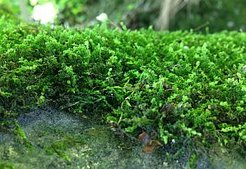Weathering of rocks by lichens and mosses explains climate effects during Ordovician

Mosses on a rock, photo: Stockholm University
Philipp Porada, a former doctoral candidate in the research group of Axel Kleidon at the Max Planck Institute for Biogeochemistry and first author of the study, is astonished that tiny non-vascular plants may affect the global climate in the long run.
Lichens and mosses extrude a cocktail of organic acids resolving the rock surface and releasing important minerals for the plants. During this process atmospheric carbon dioxide is consumed. With the global spreading of the lichens and mosses in the late Ordovician this may have changed the climate.
The researchers used a process-based numerical model of non-vascular vegetation to simulate weathering by these organisms in the late Ordovician period.
Original publication
P. Porada, T. M. Lenton, A. Pohl, B. Weber, L. Mander, Y. Donnadieu, C. Beer, U. Pöschl, A. Kleidon.
High potential for weathering and climate effects of non-vascular vegetation in the Late Ordovician.
Nature Communications, 2016; 7: 12113
DOI: 10.1038/ncomms12113
